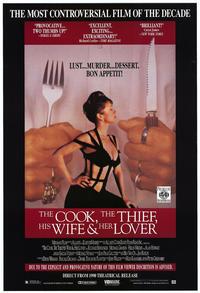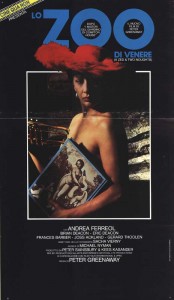The Film Vault is a monthly feature designed to showcase critically-acclaimed films that had limited commercial release and/or success. Each feature highlights films that focus on a specific theme, genre, or technique designed to provide a greater understanding of film as entertainment and art form.
Whereas a previous installation of the Film Vault introduced Gaspar Noé’s surreal approach to cinematic art, the works of Peter Greenaway are based in classic painting. Greenaway was training as a muralist when he began making films. Heavily influenced by Renaissance and Baroque art, his style stands apart.
THE COOK, THE THIEF, HIS WIFE & HER LOVER (1989)
Director: Peter Greenaway
Trailer: http://www.youtube.com/watch?v=nXLRdeYFHss
Headed by one of the most crass and sadistic characters ever on screen, Greenaway’s most well-known work is a social commentary, a work of art, and a simple, but powerful story.
A gang leader (Michael Gambon), accompanied by his wife (Helen Mirren) and his associates, entertains himself every night in a fancy French restaurant that he has recently bought. Having tired of her sadistic, boorish husband, the wife finds herself a lover (Alan Howard) and makes love to him in the restaurant’s coziest places with the silent permission of the cook (Richard Bohringer). (Synopsis by Yuri German)
Notoriously slapped with an X rating (now NC-17) despite a void of pornographic elements, the film is certainly shocking—but not for the reasons you would expect. The opening sequence pushes the thief’s overblown mistreatment of the chef in the audience’s faces and never ratchets down the intensity. The thief is contrasted by the even restraint of his wife, who sits serenely by as be berates his inferiors while the thief and his thugs parade around in the frilled coats of the gentry. While not excluded from the thief’s violent tendencies, the wife has grown accustomed to his true self. She finds escape in the arms of the silent lover nightly in different rooms of the restaurant. Of course the love tryst is discovered and ended with graphic savagery by the thief.
The deftest touch in the film is the creation of a fantasy world, where characters’ costumes quickly change as they move between rooms, coupled against the conflict of inhumanity and civility. Like a living piece of art, the set flows between scenes in long camera sequences spliced together. The film is a visual work to behold, only limited by the technology of the time period in which it was produced.
The film’s role as a political commentary against the British people’s protest of Margaret Thatcher’s poll tax is debatable. The characters can certainly be made to fit the mold, but it is disingenuous to consider the film only in this light. Greenaway claims “The Cook” was inspired by Jacobean revenge tragedies, but even this explanation is too shallow for the strength of the final product. One thing is certain, Greenaway set out to make a film that never compromises and succeeded spectacularly.
Acting 3.75
Character 4.00
Structure 3.50
Writing 4.00
OVERALL 3.75
A ZED AND TWO NOUGHTS (1985)
Director: Peter Greenaway
Trailer: http://www.youtube.com/watch?v=QHW5G6JD0Ro
If Greenaway made a film about his obsessions, this would be it. It’s a simple story about art, sex, and decay that delves into philosophical questions so varied it will require multiple viewings to take it all in.
This twisted black comedy is obsessed in turn with swans, twins, and decay. Alba Bewick (Andréa Ferréol) is involved in a swan-related car accident near the zoo. The accident kills two other women, the wives of two twin zoologists, Oliver and Oswald Deuce (Brian and Eric Deacon). Alba is lucky enough to escape with one leg. Eventually her doctor also removes the other “because it was dangerous for the spine.” Meanwhile, the Deuce brothers, as a result of losing their wives, have become fascinated with the decay of corpses, and they start making rather gruesome time-lapse films to examine the process more thoroughly. Both brothers become involved with Alba. (Synopsis by John Voorhees)
Perhaps the most bizarre aspect of the film is the characters of Oliver and Oswald, who approach their lives as if their interactions were science projects. Expressing the grief of losing their wives by categorizing and filming decaying zoo animals is a head scratcher to the contemporary film audience. Greenaway’s secret is that he has no interest in the traditional film traits of character development. He is out to make a work of art by coupling the storybook actions of Shakespearian characters that are stripped to their basest of existence.
The noble goal of remaking film into art works when set against the naturalism of the subject matter. The dark comic satire that unravels from this mission is too complex—which Greenaway even admits on the commentary track of the DVD. The level of detail is cosmic in its scope. Even the tag on the dead dog’s collar reads “Dido” instead of “Fido,” an illusion to the Queen of Carthage’s suicide. Unfortunately this leads to the characters being lost in the cloud of ideas floating through the film.
However, while the ideas may sink the ship, the visual style is masterful. Enlisting the assistance of French cinematographer Sacha Vierny, the two attempted to emulate the works of Vermeer. The result is stunning – a still-life painting coupled with an obsession with symmetry. Additional touches like embellishments such as reversing the striping pattern of the animals throughout the film develops a resonance.
Certainly not as “watchable” as “The Cook,” this film is headache-inducing with its complex philosophical themes. What it lacks in storytelling it makes up in artistic style and is worth viewing for that reason alone.
Acting 3.25
Character 3.00
Structure 3.00
Writing 4.00
OVERALL 3.25





Leave a Reply
You must be logged in to post a comment.